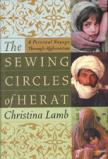A Life Devastated
Lest anyone forget, a war is still being fought in Afghanistan. Moreover, the capture or death of Osama bin Laden does not signal victory in that campaign. If the objective is to make that region a less receptive host to future terrorists, then Afghans on the ground will decide success. This will be difficult to determine with spy satellites or electronic surveillance.
The award-winning British journalist Christina Lamb, in her new book, The Sewing Circles of Herat, provides unclassified human intelligence that enables the reader to assess the probable outcome of the war on terrorism in that area of the world. Lamb is a source I trust. I first met her in besieged Kabul in June 1989. Her reports then indicated the surprising strength of the Najibullah regime at a time when Western embassies had been evacuated in expectation that the mujaheddin would soon be fighting their way into the Afghan capital.
The term cover is usually associated with intelligence operatives. However, the title of Lamb’s book is taken from the Golden Needles Ladies Sewing Classes, which met under this pretext to study under the tutelage of a male professor.
Afghanistan is a region where men remove their shoes to pray but keep their guns beside them even inside a mosque. Yet in Herat, the author found that the poet Khafash had fought the Taliban oppression by writing and circulating poetry.
Poets can be found among the fighters with guns. In Kandahar, for example, Ms. Lamb met a 22-year-old named Nazzak. A former Taliban policeman, although an Alliance mole, the now Commander Nazzak leads a pro-government force, if he is still alive. He valued very much the poetry of one of his fellow fighters, Abdullah.
Abdullah was the last man alleged to have been executed by the Taliban in Kandahar, dying just 24 hours before the Taliban evacuated the city. He was accused of being a spy for the Northern Alliance warlords, which apparently he was. Lamb’s book includes fragments of his poetry, as well as an account of a visit to his widow and four children. She notes that Abdullah’s oldest son, age 12, is learning how to handle a Kalashnikov, but she saw no evidence of any inherited poetic talent.
In stark contrast to Nazzak is a 19-year-old repatriated refugee, who was Ms. Lamb’s interpreter for her Kandahar adventures. Only money kept him in Kandahar, which once boasted that 40 varieties of grapes grew in the vicinity.
On her trip in the weeks following the events of Sept. 11, 2001, the author visited in Kabul with Afghanistan’s interim president, Hamid Karzai, whom she had met on the earlier sojourn. Although at that time, she notes, he had no bodyguard of his own, those of another warlordto everyone’s amazementprotected him. Today, of course, he is closely protected by foreigners.
Although Lamb does not speak about poets in Kabul, she does mention the dedication of Dr. Mohammed Yusuf Assefi who, in order to preserve his art under the Taliban rule, painted over his oil paintings with watercolors to hide the images that offended the Taliban. The author also recounts her meeting with Umar-akhan Masoddi, the director of the once proud Kabul museum, which is now the depository of a collection of shattered artifacts and priceless world-heritage items. He is attempting to piece them together, bit by bit.
Most important, in Kabul Lamb met Marri, an English teacher whose letters to the author introduce each chapter of the book. As a woman, Marri does not have the stake in power that many Afghan males do. Thus, she provides a more balanced insight into how thoughtful Afghans interpreted the campaign against terrorism in their country and what they hoped would be the outcome.
Also populating the pages of The Sewing Circles of Herat are some Talibs the author knew from her 1989 sojourn in Kandahar, as well as a Taliban torturer and a former Taliban deputy minister of defense, whom she met hiding in Quetta after Western troops had arrived in Afghanistan.
Previously expelled from Pakistan in 1989, Lamb was again asked to leave in 2001. However, she did manage a return visit to retired Pakistani General Hamid Gul, who was head of the powerful Inter-Service Intelligence Directorate in 1989. As she describes it, his influence is still evident in the support of the Taliban movement that can be found in Pakistan.
The strength of this book is its very human dimension, captured so well in its many black and white photographs. In a Herat bazaar, for example, the author witnessed a shopkeeper selling single shoes, an indication of how large the market is for such items among landmine victims. What she says about a line of men waiting with nothing to wait for is a subliminal plea for the international community to give these people something indeed to wait for.
Waiting for Allah, the book Lamb wrote in 1991, foreshadowed the situation that would lead to the emergence of Taliban rule and the role of Pakistan in the Afghan tragedy. The Sewing Circles of Herat provides unsettling glimpses of the people of Afghanistan. I am a man who has given his youth to the struggle for a place that no longer exists, someone tells Lamb. Her book is an enlightening, revealing and moving account of a devastated people and will help readers in forming their own personal assessment. It remains to be seen whether or not this latest in a long history of foreign interventions will invalidate that man’s statement.
This article also appeared in print, under the headline “A Life Devastated,” in the April 7, 2003, issue.








